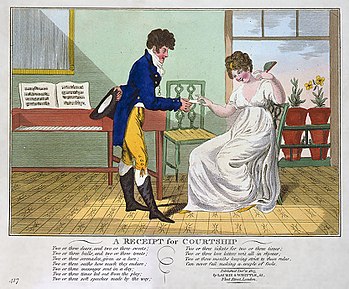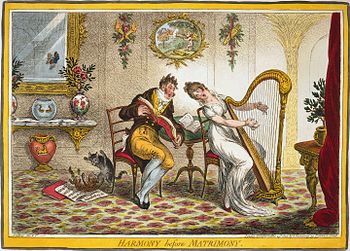 |
| 1805-courtship-caricature (public domain: Wikipedia) |
In previous centuries that relied upon arranged marriages, courtship was more a seducer’s art. But at the dawn of the 19th century, it became the road leading to matrimony. Conduct literature proliferated in response to the new anxieties and uncertainties of finding a proper mate. Since young people now enjoyed a degree of choice over their marriage partner, they needed advice on how to judge character, how to behave in public toward the opposite sex, how to attract the opposite sex, even the proper way to make or refuse an offer of marriage.
Thus, strict rules for behavior during courtship developed. The rules safeguarded both sexes. Gentlemen required protection from being trapped into matrimony, and ladies needed to be guarded from becoming attached to men who were not sincere in their intentions toward them.
Initiating a Courtship
I cannot even understand how it is flattering to a man's vanity, to gain the affections of a deserving and too credulous woman, whom he never intends to marry. He ought to lose more in his character for integrity, than he can gain as one successful in courtship. His manner of address, consisting of a visible attachment. While his heart is not engaged, is most detestable hypocrisy. And to say that he is not bound in honour, because he has subjected himself to no specific promise, is the highest aggravation of his guilt. Were he to act in the same manner in his common transactions with mankind, his character would be forever blasted. (Gener, 1812)
A woman is often placed in a very delicate situation. She may be distinguished by a kind of attention which is calculated to gain her affections, while it is impossible to know whether the addresses of her pretended lover will end in a serious declaration. (Gener, 1812)As in most things in society in that era, men played the active role in the prescribed procedure for proper courtship. Moreover, “the scarcity value of men in Jane Austen's lifetime, together with women's dependence on husbands for status and financial security, gave eligible bachelors the power to act as connoisseurs.” (Jones, 2009)
Women had to wait for pursuit by a suitor. Siblings and friends could be recruited as messengers to alert a potential suitor of a young lady’s inclinations, but she could take no further initiative. Even if a suitor made the first move, she was expected to behave with considerable reserve and not openly encourage a man’s suit.
ONE of the chief beauties in a female character is that modest reserve, that retiring delicacy, which avoids the public eye, and is disconcerted even at the gaze of admiration. (Gregory, 1774)Ironically, the one area in courtship where the lady might have an active role was in refusing unwanted attentions. This restricted her choices from among those who made advances toward her. It was not uncommon for a woman to feel pressured to accept the first reasonable offer they received, since another might never come their way.
A woman’s sterling reputation enhanced her value in the marriage market and increased the likelihood of receiving the attention of eligible young men. Thus, an etiquette of courtship developed to help guard against impropriety of any kind that could damage her reputation.
Discretion in all things
For the Gentleman
Those marriages generally abound most with love and constancy, that are preceded by long courtship. The passion should strike root, and gather strength before marriage be grafted on it. A long course of hopes and expectations fixes the idea in our minds, and habituates us to a fondness of the person beloved…(The Young Husband's Book 1839.)
 |
| In Harmony before Matrimony (1805), James Gillray caricatured a courtship in which the couple sings together from Duets de l'Amour. (Photo credit: James Gillray [Public domain], via Wikimedia Commons) |
For the Lady
The Advantages of being reserved are too many to be set down; we will only say, that it is a Guard to a good Woman, and a Disguise to an ill One. It is of so much Use to both, that those ought to use it as an Artifice who refuse to practice it as a Virtue. (The Whole Duty of a Woman, 1737)Female conduct manuals universally cautioned women not to be forward in their dealings with men or to encourage their advances. A woman must never confess her feelings until absolutely convinced of his intentions. Some went so far as to insist a woman must never look at a man unless he made the first advance. Not surprisingly, it was difficult for either party to truly discern the feelings and intentions of the other. Only at the moment an offer of marriage was made could a man declare his feelings and a woman her own in return.
Do’s and Do Nots of Courtship
Chaperones
 Young women were protected zealously in company. Young, unmarried women were never alone in the company of a gentleman, save family and close family friends. A chaperone was also required for a young single woman to attend any social occasion. Under no circumstances could a lady call upon a gentleman alone unless consulting him on business matters, and she never forced herself upon a man's notice.
Young women were protected zealously in company. Young, unmarried women were never alone in the company of a gentleman, save family and close family friends. A chaperone was also required for a young single woman to attend any social occasion. Under no circumstances could a lady call upon a gentleman alone unless consulting him on business matters, and she never forced herself upon a man's notice.Except for a walk to church or a park in the early morning, a lady could not walk alone. She always needed to be accompanied by another lady, an appropriate man, or a servant. Though a lady was permitted to drive her own carriage, if she left the family estate, she required the attendance of a groom. Similarly, on horseback she needed an appropriate companion to protect her reputation.
Conversation
There is another Character not quite so criminal, yet not less ridiculous; which is, that of a good humour'd Woman, one who thinketh me must always be in a Laugh, or a broad Smile, because Good-Humour is an obliging Quality; thinks it less ill Manners to talk impertinently than to be silent in Company. (The Whole Duty of a Woman, 1737)
Touch
Gifts
Once engaged, couples were expected to proclaim that fact clearly, in part ensuring that neither could back out without serious social repercussions. The serious matter of betrothals and the business that accompanied them will be the focus of the next installment of this series.
Find previous installments here:
Get Me to the Church on Time: Changing Attitudes toward MarriageTo Have a Courtship, One Needs a Suitor
References
Gener, S., and John Muckersy. M. Gener, Or, A Selection of Letters on Life and Manners. 3rd ed. Edinburgh: Printed for Peter Hill ..., A. Constable & and A. MacKay ;, 1812.Gregory, John. A Father's Legacy to His Daughters By the Late Dr. Gregory, of Edinburgh. The 2nd ed. London: Printed for W. Strahan ;, 1774.
Jones, Hazel. Jane Austen and Marriage. London: Continuum, 2009.
The Whole Duty of a Woman, Or, an Infallible Guide to the Fair Sex. Containing, Rules, Directions, and Observations, for Their Conduct and Behaviour through All Ages and Circumstances of Life, as Virgins, Wives, or Widows. With Directions, How to Obtain All Use. The 2nd ed. London: Printed for T. Read, in Dogwell-Court, White-Fryers, Fleet-Street, 1737.
The Young Husband's Book a Manual of the Duties, Moral, Religious, and Domestic, Imposed by the Relations of Married Life. Philadelphia: Lea & Blanchard, 1839.
~~~~~~~~~~~~
Maria Grace is the author of Darcy's Decision, The Future Mrs. Darcy, All the Appearance of Goodness, and Twelfth Night at Longbourn, Remember the Past, and Mistaking Her Character. Click here to find her books on Amazon. For more on her writing and other Random Bits of Fascination, visit her website. You can also like her on Facebook, follow on Twitter or email her.

Fun read! Thanks!
ReplyDeleteGreat read. Thanks!
ReplyDeleteExcellent post! Thank you. For those in the historical fiction field, these rules can't just be read, but must be studied!
ReplyDeleteThanks for the post.
ReplyDelete